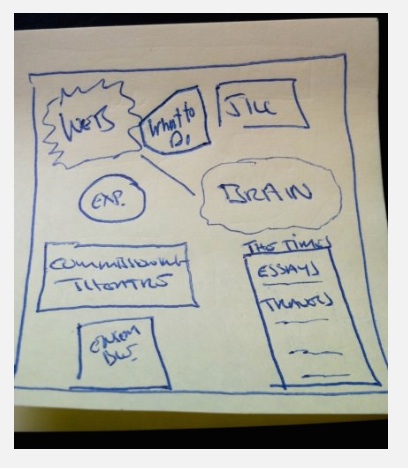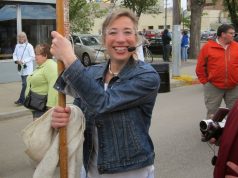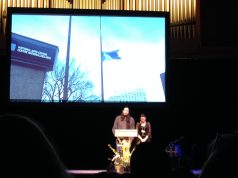A google chat at the end of the work day between Graham F. Scott (SWS Digital Dramaturg) and Laurel Green (Artistic Associate).

When Graham first started working with SpiderWebShow he created a proposal to become the site’s ‘digital dramaturg’. It’s fascinating and got him the gig – you can read it here: gfscott.com/sws
Laurel: Hold on…I’m trying figure out how to download a script I’m reading to the hard drive on my Kobo. That to me is Digital Dramaturgy.
Graham: Haha.
Laurel: Ok, here now. Hi. Graham, I’m a dramaturg at ATP where I work with playwrights as they develop their new scripts, read plays for future programming, and I’m the sorta ‘resident contextualizer’ for the plays in our season. I’m curious about your use of the word dramaturg in terms of your work for SWS, and I’d love to hear more about your practice.
Graham F: It made sense to me because the original goal of the SWS was to build a “National Theatre” that made sense for the Internet age. Reading the original proposal, I felt that it was going to be actually very difficult to separate the project’s artistic goals from their technical realization. Which is why I kind of asserted myself a bit more and said that not only was I going to write some code, but I had to have some sort of advisory role, helping the creators see the technical limits, but also the technical possibilities.
Laurel: Which makes sense that in a dramaturgical role you would function as a technical facilitator, editor and writer. When I’m working on a script I have to keep the audience’s understanding and experience front of mind. Also, I’m thinking about how content informs the shape and style of the piece.
Graham F: Yeah! And for me I think it’s also about maintaining a little critical distance during the creative process, and posing questions that might help clarify what’s going on for the creators who are so deeply embedded in it. Like: “Here’s what I’m seeing and hearing. Is that what you intended?”
Laurel: I think that critical distance is totally key to working as a dramaturg. So, can you share some anecdotes about what it’s been like to work on SWS thus far?
Graham F: Sure. It has involved a lot of Google Hangouts, because we’re all seldom in the same city. So a lot of highly-pixellated streams of Sarah beaming in from Saskatoon or St. John’s or Vancouver or wherever she is that day. We had early arguments about how to translate the name into the design….because the name was meant to evoke the web of theatrical creators across the country who were collaborating on it. If you literally drew the lines on a map it would be this crazy spider’s web.
Laurel: Ah, yes.
Graham F: It’s a metaphor—and a perfectly good one! I was dead-set against actually using an image of a spider, however. Very early on, there were a bunch of visual things we decided we could never, ever use for this project:
no spiders
no red curtains about to be raised
no laughing/crying drama masks
no Matrix-y computer code
Much of that was just to try and inoculate ourselves against kitsch and cliche.
But also: I thought it was important that we get closer, visually and conceptually, to where contemporary “net art” is right now…or I should say, where it was last year. (It moves pretty fast)
Laurel: It does move fast. I think that’s part of the anxiety over how to design one’s space online…
Graham: Exactly. And “space” was a word we actually haggled over a whole lot. Because: I argued that the idea of “space” was wrong for an online venture.
Laurel: Interesting. Why?
Graham: The whole idea of the internet as a “space” seemed, to me, a bit creaky in 2013. Like when someone says “information superhighway” or “cyberspace” — it’s this hangover from the ’90s, when all of the imagery related to computers and the internet is explicitly spatial: think cyberpunk classics like Lawnmower Man or Hackers or The Matrix. When in reality, the internet is a bunch of people sitting at their desks or waiting for the bus playing with their phone or whatever.
Laurel: So it’s more fluid?
Graham F: Perhaps less fluid! I thought it was important to discard some of those romantic metaphors about the web. The experience of the web today is largely textual. It’s your Facebook newsfeed, your Twitter stream.
Laurel: Right. So, not a big ‘space’ full of ‘fluid’?
Graham F: That resistance to spatial metaphors is what drove the design — trying to flatten it and make it (relatively) straightforward.
Laurel: How does the site produce online performances?
Graham F: I built a website where we could showcase what people were doing. And that performance has taken all sorts of forms. One of the successes of SWS is that it’s done stuff that I think gets beyond the most obvious adaptation of theatre to the internet, which is video. I’d cite Adrienne’s audio postcards, and Mat’s photo tableaux series. In both cases it definitely feels like there’s a “performance” going on, but it’s not “turn camera on, act scene, turn camera off”. Not that there’s anything wrong with that.
Laurel: Nor is it “turn on, watch something, and turn off” for the audience.
Graham F: Yes! I hadn’t even thought of that, but it’s true for the audience as well. I seldom scrutinize photos as closely as I do Mat’s in that series, which I think is testimony to the power of the concept theatrically. It’s got that riveting quality that the best live theatre does.
Laurel: Absolutely.
Graham F: I think mobile is actually where we have the most work to do in future, in terms of trying to find performance possibilities and adhering to the principles of Responsive Design — meaning that the site displays differently, and displays well, whether you’re looking at it on a big screen or a little one. So we’ve done some stuff with audio, with images, with video on YouTube. But what’s a performance on Instagram? On Snapchat? On Yo? And people are doing all that stuff already: it must be said. I don’t think we’re late to the party, by any means, but a lot of these mediums already have emergent aesthetics, stars, fandoms.
Laurel: What do you think about SWS adding livestreaming to capture and share events happening across the country?
Graham F: Livestreaming is going to be important, but I think a big part of livestreaming it at the time is also archiving it for the future. Like, most people who watch the video don’t do it while it’s actually happening; they watch when they can, which is usually later. The important part is being there to capture events that would otherwise be quite ephemeral: panel talks are so in danger of that.
Laurel: Another dramaturgical revelation is the ability to collaborate across distance using google hangouts, trello, etc. Working on SWS there’s a behind-the-scenes experiment with making art via technology that is ongoing also.
By the way, I managed to solve my Kobo issue only about five minutes ago…
Graham F: You were multitasking.
Laurel: Weeellll, I was telling myself that I would just try ‘one last thing’ after letting it sit.
Graham F: It’s amazing how often that one last try does it.
Making things easy is super-hard.
Laurel: That is a good dramaturgical motto.









